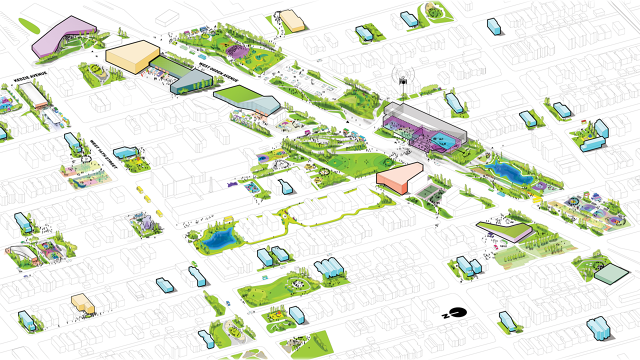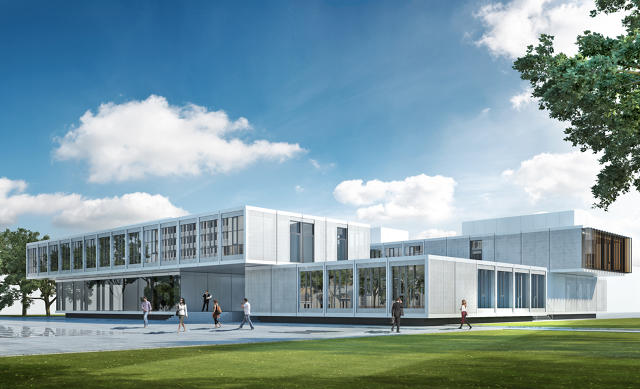5 big ideas From The Chicago structure Biennial
How design might heal the fractured relationship between people and police and different key takeaways from the Chicago architecture Biennial.
October 8, 2015
it is safe to say that architecture and Chicago’s historical past are inextricably linked. the city was the stomping grounds of Bauhaus nice Mies van der Rohe. Frank Lloyd Wright had his residence and studio in o.k.Park. Louis Sullivan built one of the world’s first skyscrapers there. Postmodern pioneer Stanley Tigerman and contemporary impresario Jeanne Gang are based in the city. And for the following three months, Chicago is host to the first architecture biennial in North america.
primarily a three-month-lengthy exhibition and roster of public lectures and occasions, the Chicago structure Biennial brings collectively the work of over one hundred leading designers, architects, and artists in a survey of what’s happening within the field. Installations grapple with know-how, housing, and sustainability and question the function of design in shaping the arena. five of the biggest ideas presented on the Biennial are below.

Design might Heal The Fractured Relationship Between people And Police
Jeanne Gang has made headlines for her revolutionary initiatives including razor-edged skyscrapers and restorative landscapes. For the Chicago Biennial, her firm, Studio Gang, tackled one of the vital urgent concerns in the metropolis: crime.
The impetus happened when Gang was working on a design for a Brooklyn fireplace home.
“We started to understand that the firemen have a robust feel of neighborhood with each and every other and with the group around them,” Gang says. “fireplace home doors are often open and people can are available and speak to them. i assumed, what’s the architecture of the police station around the usa like? right round that time, the President’s activity pressure on 21st-Century Policing file got here out, which has recommendations grouped into six pillars. I was once just curious, might any of this be spatialized?”
Gang took the six pillars—building trust and legitimacy, know-how and social media, training and schooling, policy and oversight, group policing and crime reduction, officer well-being and security—and applied them to architecture. She traced the history of police station typology over time and saw that over time the design become further and further faraway from its surroundings, ultimately becoming the unwelcoming fortresses we see today. Her idea hinges on the use of design to inspire more certain interactions with police starting with how you can embed departments into their communities.
“the two prongs are ‘police station turns into community center’ and cops are ‘atomized’ and become a part of the neighborhood,” she says. Her conceptual proposal contains things like having computer systems with public web get right of entry to within the stations; developing shared athletic amenities; constructing police housing in neighborhoods the place there is an abundance of vacant houses; planting group gardens. Gang factors out that some present policy may no longer make a few of these proposals possible. as an instance, in New York city officers can’t reside within the precincts they patrol. moreover, there was no consumer; the agency could let its concepts run wild. alternatively, much of this is actionable. one of the crucial ideas, turning parking lots into basketball courts, used to be actually built at a Lawndale police station and was once met with pleasure when it opened this weekend. That stated, Gang views the Polis Station as a more potent dialog starter than a blueprint.
“we need one thing,” she says. “The violence within the neighborhoods is truly excessive and the conflicts between the police and group are extra seen. this can be a nice time to take a look at and tackle this problem from more than one vantage factors…creating relationships and constructing belief—that is the place architecture can have a strong impact.”

architecture within the twenty first Century Is Open source, not about a Single Visionary
“The role of architect needs to shift to be more of a facilitator, a curator of concepts, a synthesizer,” Jeff Risom, managing director at Gehl Architects‘ big apple place of business, says. Risom, who spoke on a panel referred to as world views on Chicago and the future of city exchange, argues that the era of the “master Builder” is over.
“we’ve got entrusted architects and lawyers to make cities and we all know that it can be much more complex that that,” he says. “What we in point of fact love about cities is public lifestyles—the vibe, the power—and that’s the reason about social science, city economics, ecology, and so many different issues. Architects and legal professionals aren’t experts in that. different disciplines should have a say.”
He advocates more public participation and transparency right through the design and planning process.
“If architects can take a look at and translate and put a few of that culture and lifetime of a place in a bodily form, which is still great,” Risom says. “but they must be just right at facilitating conversations, shortening the gap between cities and determination makers, providing systems, growing equitable environments, or asking technical questions about giant investments like infrastructure. To be clear, it’s no longer about eliminating architects and designers and changing them with electorate—it can be an add. it’s a extra cheap distribution of responsibility. to resolve this incredibly complicated problem of existence in the metropolis, it is no longer just about magnificence or functionality—it can be about how we reside. Designers have a task, but now not the one position and the master imaginative and prescient.”

massive-Scale Infrastructure will have to Multitask
native firm UrbanLab has a project referred to as “Filter Island” in the exhibition different scenarios for Chicago. Principals Sarah Dunn and Martin Felsen directed their attention the the town’s waterfront and took a web page from planner Daniel Burnham’s guide and considered a bold, large-scale challenge to fight water air pollution and provide more public area in one fell swoop.
“Monofunction was how infrastructure used to be dealt with within the 20th century,” Dunn says. “We as architects and designers are fascinated with leveraging one move to create other issues. We’re in reality considering using infrastructure to supply new cultural area for town. it’s essential easy the water in underground tanks with a lot of industrial strategies, however if you’re going to spend $1 billion, why not produce a cultural panorama? If water is the new oil—and Chicago has plenty of it—then we should be pondering more well concerning the tools we have with regards to social amenity and commerce.”

structure is not restrained To structures
Co-artistic directors Sarah Herda and Joseph Grima did not invite the Biennial’s participants to riff on a selected theme, however habitual concerns and considerations organically emerged within the work. “probably the most accepted was once the agency of the architect,” Herda says. “Architects around the world are carving out new the way to practice and new tips on how to make architecture subject in the world. they are not ready for a quick; they’re taking up the chances and opportunities that they see round them. We actually see the exhibition as a web page of experimentation. it is not a place to take a look at pictures of structures; it is a spot to determine the way forward for buildings.”
as an instance, Andres Jacque and his firm, the administrative center of Political Innovation, revisited Charles and Ray Eames’s classic film the Powers of Ten in a performance piece referred to as the Superpowers of Ten. The play discussed pressing social issues through an environmental lens, the whole lot from meals production to house particles.

Adaptation Is essential For buildings
The Harvard GSD’s Adaptive structure and sensible supplies convention explored the connection between science and building. as an instance, how can innovation yield extra sustainable cities? Making structures extra conscious of their surroundings is one avenue and smart glass might be a vehicle.
“constructions at a certain scale want to be constituted of glass, however we feel environmentally irresponsible making them,” says Eric Höweler, primary of the Boston firm Höweler + Yoon and a Harvard professor. whereas glass has lengthy been a favourite building material for modern architects, it’s lovely dangerous from an vitality standpoint as the fabric transfers warmth. (in the summer, it takes various vitality to cool and within the winter, a lot of energy to chill.) a couple years in the past, Merck employed Höweler + Yoon to analyze the possible purposes on glass embedded with liquid crystals. at the Biennial, Merck published designs for a forthcoming innovation middle in Germany that uses new materials—like smart glass—to lend a hand curtail vitality use.
“it can be in reality attention-grabbing to take into consideration a microscopic factor that would impact the architectural scale of a city,” Höweler says. “if you add a stage of regulate to glass, you are taking something mysterious and unstable and you are in a position to keep an eye on it. This addresses tendencies of the flexibility of buildings to smarter and enthusiastic about constructing upkeep control programs as no longer being now not separate [from the structure]. building technology should not just be for technicians, it will have to be for designers.”
For Jeanne Gang, who also presented at the conference, adaptability is smart from the standpoint of maintaining with the most efficient expertise. “at first of my apply, I used to be trying to put expertise into the surfaces of my structures,” she says. “however as I noticed how briskly tech was changing, i thought certain forms of expertise will have to be plug-and-play. If they are adaptable that you may upgrade.”
The Chicago architecture Biennial runs unless January 6, 2015. visit chicagoarchitecturebiennial.org for programming important points.
quick company , learn Full Story
(89)














